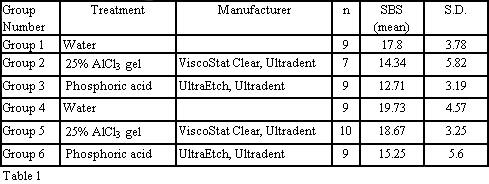ABSTRACT: 0375
Shear bond strength of resin cement to treated dentin surfaces
| A. KEHLER, and T. BONSTEIN, University of Manitoba, Winnipeg, Canada | |
Objective: To evaluate the shear bond strength (SBS) of resin cement to human dentin following dentin surface treatment and impression taking; to examine the affect of aging on SBS. Methods: 25 caries-free molars were sectioned, yielding 60 dentin surfaces then embedded in self-curing resin and wet ground with 180-grit silica paper. Specimens were divided into 6-Groups (n=10) based on 3 different surface treatments and 2 storage times. Group1 and Group4 received water treatment, Group2 and Group5 were treated with a 25% AlCl3 hemostatic agent (ViscoStat Clear, Ultradent). Group3 and Group6 were 35%phosphoric acid etched for 15 seconds (UltraEtch, Ultradent). Dentin surfaces were dried with cotton and received a PVS impression (ImprintII Light Body, 3M ESPE) according to manufacturer's instructions. Bonding agent (One Step Plus, Bisco) was applied to specimens according to manufacturer's directions. A 2.38mm diameter mold (UltraDent) was applied on the dentin and filled with resin cement (DuoLink, Bisco) followed by light cure. Specimens were stored in water at 37°C. Groups 1-3 were sheared after 24hours using the Notched Shear Bond Test (Ultradent) in a Zwick mechanical testing machine with crosshead speed of 1mm/min. Group4,5,and 6 were aged for 30 days before mechanically testing. Results were analyzed using a one-way ANOVA analysis (α=0.05). Results: Groups1-6 showed an increase in SBS means as follows; water treatment>AlCl3>phosphoric acid however this increase was statistically significant only between the water treated groups and phosphoric acid groups. SBS values for Group1 and 4 combined were statistically different from values for Group3 and 6 combined (p<0.05). Specimen SBS increased significantly with aging (p<0.05). See table-1. Conclusions: Within the limitations of this study, results show the use of phosphoric acid may decrease bond strength initially. Bond strength of the cement to dentin increases with time. Acknowledgements: Manitoba Medical Service, Bisco, Ultradent.
| |
| Seq #70 - Cements 2:00 PM-3:15 PM, Thursday, July 3, 2008 Metro Toronto Convention Centre Exhibit Hall D-E | |
|
Back to the Dental Materials 1: Adhesion - Bond Strength Testing and Mechanisms Program | |
©Copyright 2008 American Association for Dental Research. All Rights Reserved.
